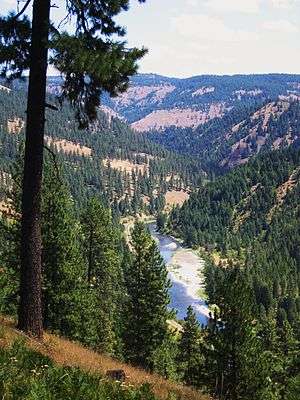Wenaha River
The Wenaha River is a tributary of the Grande Ronde River, about 22 miles (35 km) long,[4] in the U.S. state of Oregon. The river begins at the confluence of its north and south forks in the Blue Mountains and flows east through the Wenaha–Tucannon Wilderness to meet the larger river at the small settlement of Troy.[7] A designated Wild and Scenic River for its entire length,[4] the stream flows wholly within Wallowa County.[2]
| Wenaha River | |
|---|---|
 Wenaha River | |
 Location of the mouth of the Wenaha River in Oregon | |
| Etymology | Perhaps from a Cayuse language placename[1] |
| Location | |
| Country | United States |
| State | Oregon |
| County | Wallowa |
| Physical characteristics | |
| Source | confluence of the river's north and south forks |
| • location | Wenaha–Tucannon Wilderness, Blue Mountains |
| • coordinates | 45°57′03″N 117°47′39″W[2] |
| • elevation | 2,807 ft (856 m)[3] |
| Mouth | Grande Ronde River |
• location | Troy |
• coordinates | 45°56′44″N 117°27′07″W[2] |
• elevation | 1,601 ft (488 m)[2] |
| Length | 21.6 mi (34.8 km)[4] |
| Basin size | 296 sq mi (770 km2)[5] |
| Discharge | |
| • average | 390 cu ft/s (11 m3/s)[6] |
| Type | Wild, Scenic, Recreational |
| Designated | October 28, 1988 |
Course
The source of the North Fork Wenaha River is near 46.0456°N 117.9043°W at 5,700 feet (1,700 m) in Washington state, while the South Fork Wenaha River source is near 45.8752°N 117.9374°W at the same elevation in Oregon. From the confluence of the forks at 2,800 feet (850 m) in the Wenaha–Tucannon Wilderness within Umatilla National Forest, the Wenaha River flows generally east through the Blue Mountains of northeastern Oregon.[7]
In the wilderness, tributaries enter the river in the following order headed downstream: Beaver Creek, Slick Ear Creek, and Rock Creek, all from the left; Big Hole Canyon from the right; Butte Creek, left; Swamp Creek, right; Weller Creek, left; Cross Canyon, right; Fairview Creek, left; Burnt Canyon, right; Crooked Creek, left. Below Crooked Creek, the river leaves the wilderness, turns southeast and exits the national forest. Turning east again, the Wenaha River empties into the Grande Ronde River at Troy, about 45 miles (72 km) from the larger river's confluence with the Snake River.[7]
Recreation
The Wenaha River Trail, about 31 miles (50 km) long, parallels the river and its south fork between Troy and Timothy Springs, near the Union County border. Weather permitting, the trail is open for hiking and backpacking. The trail, rated "more difficult" by the United States Forest Service, varies in elevation from 1,600 feet (490 m) at Troy to 4,700 feet (1,400 m) at Timothy Springs.[8]
Fishing along the secluded river is good.[8] Wild rainbow trout ranging in size from 6 to 18 inches (15 to 46 cm) are abundant.[9] Modest numbers of steelhead (seagoing rainbow trout) swim upriver from the Grande Ronde, though fishing for them is limited. Bull trout, which also frequent the river, are protected, subject to catch-and-release regulations.[9]
See also
References
- Bright, William (2004). Native American Placenames of the United States. Norman: University of Oklahoma Press. p. 561. ISBN 0-8061-3576-X.
- "Wenaha River". Geographic Names Information System (GNIS). United States Geological Survey. November 28, 1980. Retrieved May 3, 2012.
- Source elevation derived from Google Earth search using GNIS source coordinates.
- "Wenaha River, Oregon". National Wild and Scenic Rivers System. Retrieved December 21, 2015.
- "Wenaha River Spring Chinook Population" (PDF). Northwest Fisheries Science Center. p. 2. Retrieved May 3, 2012.
- Palmer, Tim (2014). Field Guide to Oregon Rivers. Corvallis: Oregon State University Press. p. 291. ISBN 978-0-87071-627-0.
- United States Geological Survey (USGS). "United States Geological Survey Topographic Map". TopoQuest. Retrieved May 3, 2012. The map quadrangles include river mile (RM) markers along the Grande Ronde.
- "Wenaha River Trail 3137". United States Forest Service. Retrieved May 3, 2012.
- John Shewey (2007). Complete Angler's Guide to Oregon: A Wilderness Adventures Press Angler's Guidebook. Belgrade, Montana: Wilderness Adventures Press. pp. 313–14. ISBN 978-1-932098-31-0.
External links
- Wenaha River Packrafting Video produced by Oregon Field Guide